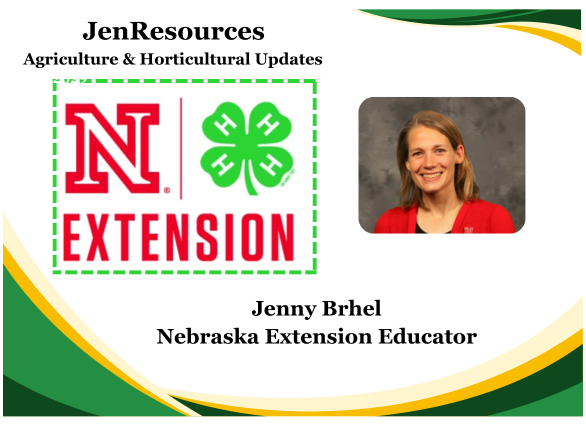Nebraska Extension Blog by Jenny Brhel
Crop Updates: I was reminding myself to count my blessings that we have received any rain falling from the sky! The rainfall has been spotty and I can appreciate it’s been frustrating and tiring with the winds and lack of rainfall. We’ve also been blessed with incredible planting conditions this season. It’s interesting to hear a number of farmers share they were completely done with planting in April this year. It’s also nice to see the green crops emerging in fields.
Have heard reports of alfalfa weevils being higher incidence in Kansas and the southern border counties of Nebraska. Please be scouting alfalfa. More info. here: https://crops.extension.iastate.edu/encyclopedia/alfalfa-weevil.
For wheat, there’s been very little rust (stripe or leaf rust) found in Kansas through Texas. With recent rains and dew, it’s good to be scouting for these diseases. While I’m not aware that we have any wheat flowering yet, wheat development does vary throughout the area receiving this information. To check on the Fusarium Head Blight (scab) risk, check out this tool: https://www.wheatscab.psu.edu/.
I’ve had some questions on what to expect for insects this year. No one can know for sure, but our Extension entomologists shared on this topic a few weeks ago in a CropWatch article found here: https://go.unl.edu/2zmn. The following are some excerpts from the article:
“Soil Temperatures: Despite frigid temperatures in February 2025, Nebraska soil temperatures at insect overwintering depths (around 4 inches) remained relatively stable due to insulating snow cover and crop residue. The cold event likely had minimal impact on most overwintering insect pests, as the soil didn’t freeze deep enough or stay cold long enough to kill them.
Unfortunately, temperatures at most locations where western corn rootworm, western bean cutworm, and wheat stem sawfly typically overwinter have not reached sustained periods of low enough temperatures to cause considerable mortality. The exception would be the chance for higher mortality of WCR and WBC in January in the Scottsbluff region.
We recommend that scouting and management practices are continued as planned in 2025, and as informed by pest pressures observed in 2024, rather than relying upon this winter’s weather to provide adequate control of pests. However, weather between now and summer could still impact insect survival; for example, very wet soil conditions in spring can reduce WCR survival as larvae hatch out and potentially drown.”
Crabgrass preventer in lawns: With the warm soil temperatures, it’s time to get crabgrass preventer on lawns if you’re interested in doing this and haven’t already done so.
Field bindweed has been another pest people have asked about. It produces deep roots and it spreads by seeds, rhizomes and stolons. For homeowners, Kelly Feehan shared that “If hand-pulling or hoeing is the chosen control, studies show if bindweed is pulled before it grows five leaves, you may have better success. It may take up to three or four growing seasons to kill a plant, but it’s possible if one stays on top of removing plants before they have five leaves. If herbicides are used, spot treat weeds before they bloom and avoid getting herbicide on desirable plants. Tryclopyr and glyphosate can be used carefully in landscapes on bindweed.” Another tip has been to apply glyphosate to a nitrile glove and run the gloved hand on the vine so the herbicide is applied to the vine and not the desirable plant. That also takes diligence but can help over time.



































